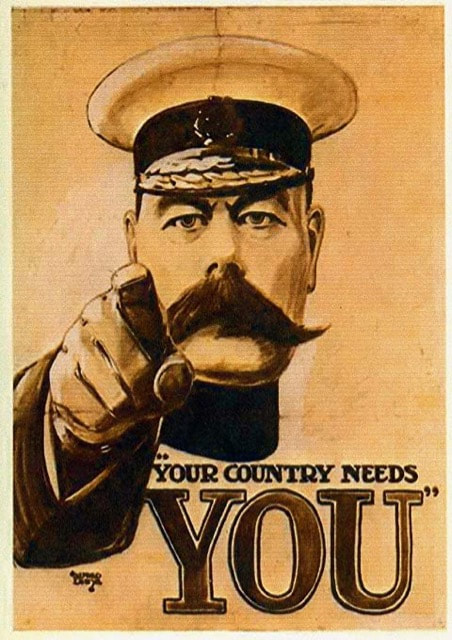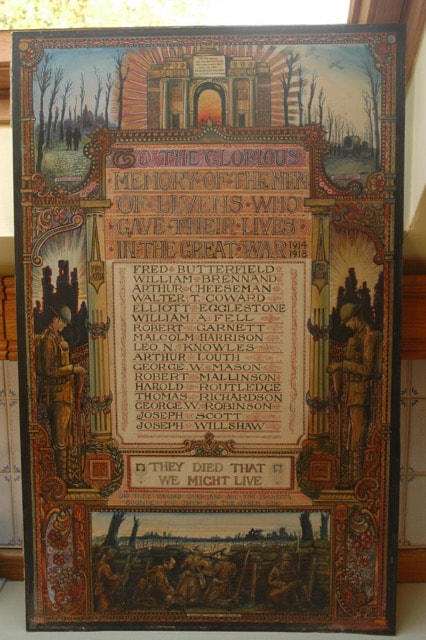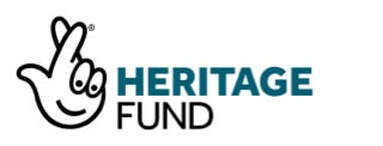The First World War and Levens
The few years up to the centenary of the 1918 Armistice saw a flood of Great War commemorative publications by historical societies all over Britain, and Levens Local History Group (LLHG) is no exception.
Our initial motivation was to commemorate the First World War by staging an exhibition which would contain whatever we could find out about anything to do with Levens in the period and relate it to the war as a whole. This exhibition was staged over the Armistice day centenary weekend in the Levens Institute and the Church of St. John the Evangelist, Levens. and was made possible by a grant from the Heritage Lottery Fund and the kindness of the many people who allowed us to exhibit their treasured family mementoes.
By necessity the exhibition contained a lot of material in the form of artefacts, memorabilia, period posters, and information displays etc. that were not strictly Levens related but which gave visitors something informative about the war to look at. This book which has evolved from the research done for the exhibition does not have any academic pretensions so there are no foot or end notes and no detailed citations for the many sources referred to in passing.. We concentrate on the people whose lives were revealed by that research and contextual material is confined as far as possible to demonstrating Levens’ participation in the conflict or in explaining references that would otherwise be obscure.
We knew at the outset that we must take the list of names on the village war memorial and flesh it out with whatever personal detail could be unearthed about them in order to make our book more than a collection of obituaries of named but otherwise anonymous participants in a distant historical convulsion. The result is defined by what we have been able to unearth.
The Great War is beyond the reach of memory so all we can know of it is what has survived from the past recorded in private or public sources or related in anecdote within families. What we have found about Levens is like a long-buried Roman mosaic floor recently uncovered but disrupted by the plough over time, some parts of it remaining fairly clear and complete, but others being fragmentary or missing, and there is the probability that the mosaic was incomplete to start with.
One generation clears out the houses of the previous, documents and photographs are destroyed or mislaid: and some of the survivors doubtless preferred to forget. The public record is fairly clear and complete and it has been relatively easy to write about those who were killed and anyone publicly prominent who had connections to institutions which still exist; much less easy to do justice to the survivors; much harder to describe how the war affected our village, and how typical of rural communities was its experience. We cannot tell what has been lost so we must be cautious about inferring too much from too little.
Our initial motivation was to commemorate the First World War by staging an exhibition which would contain whatever we could find out about anything to do with Levens in the period and relate it to the war as a whole. This exhibition was staged over the Armistice day centenary weekend in the Levens Institute and the Church of St. John the Evangelist, Levens. and was made possible by a grant from the Heritage Lottery Fund and the kindness of the many people who allowed us to exhibit their treasured family mementoes.
By necessity the exhibition contained a lot of material in the form of artefacts, memorabilia, period posters, and information displays etc. that were not strictly Levens related but which gave visitors something informative about the war to look at. This book which has evolved from the research done for the exhibition does not have any academic pretensions so there are no foot or end notes and no detailed citations for the many sources referred to in passing.. We concentrate on the people whose lives were revealed by that research and contextual material is confined as far as possible to demonstrating Levens’ participation in the conflict or in explaining references that would otherwise be obscure.
We knew at the outset that we must take the list of names on the village war memorial and flesh it out with whatever personal detail could be unearthed about them in order to make our book more than a collection of obituaries of named but otherwise anonymous participants in a distant historical convulsion. The result is defined by what we have been able to unearth.
The Great War is beyond the reach of memory so all we can know of it is what has survived from the past recorded in private or public sources or related in anecdote within families. What we have found about Levens is like a long-buried Roman mosaic floor recently uncovered but disrupted by the plough over time, some parts of it remaining fairly clear and complete, but others being fragmentary or missing, and there is the probability that the mosaic was incomplete to start with.
One generation clears out the houses of the previous, documents and photographs are destroyed or mislaid: and some of the survivors doubtless preferred to forget. The public record is fairly clear and complete and it has been relatively easy to write about those who were killed and anyone publicly prominent who had connections to institutions which still exist; much less easy to do justice to the survivors; much harder to describe how the war affected our village, and how typical of rural communities was its experience. We cannot tell what has been lost so we must be cautious about inferring too much from too little.





